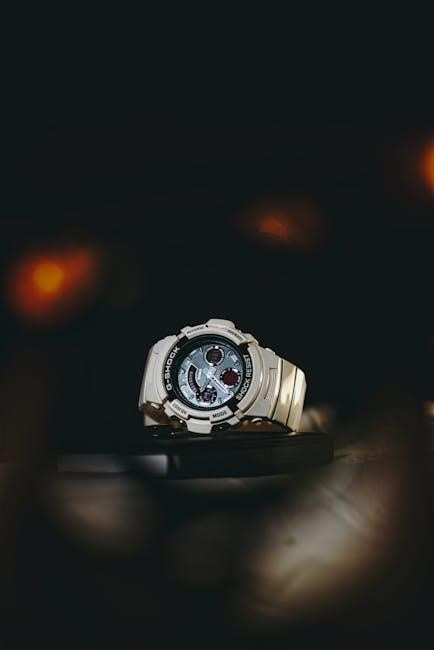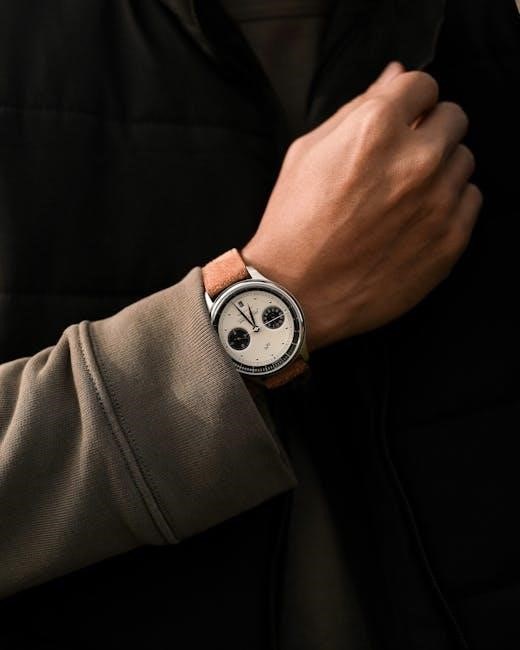Discover the essential guide to finding your ideal watch band size. Learn how to measure width and length for a perfect fit using simple tools and styles.
Why Proper Fit Matters
A proper watch band fit is crucial for comfort and functionality. A band that is too tight can cause discomfort, while one that is too loose may compromise the watch’s readability and security. The right fit ensures optimal wearability, preventing irritation and allowing the watch to function as intended. Additionally, a well-fitted band enhances the overall aesthetic, making the timepiece look more proportionate on the wrist. Ensuring the correct size is essential for both style and practicality, guaranteeing a seamless and enjoyable wearing experience.
Understanding Watch Band Measurements
Watch bands are measured by width and length. The width is determined by the distance between the lugs, where the strap attaches to the watch case. This measurement is typically in millimeters. The length refers to the combined measurement of both straps, ensuring the band fits comfortably around the wrist; Accurate measurements are key to selecting the right size, whether for a leather, metal, or nylon band. Proper sizing ensures comfort, security, and a polished look, making it essential for any watch wearer.
How to Measure Watch Band Width
Measure the width by fitting a ruler between the watch lugs. Record in millimeters for accurate sizing, ensuring a perfect fit for your strap.
Measuring Between the Lugs
To accurately measure your watch band width, place a ruler or caliper between the lugs, the points where the strap attaches to the watch case. Ensure the ruler is aligned straight and snugly fits within the space. This measurement, typically in millimeters, determines the strap size. For example, a 20mm width means the strap fits perfectly between 20mm lugs. This step is crucial for selecting the right band, ensuring comfort and proper fit.
Using a Ruler for Accuracy
To ensure precise measurements, use a metric ruler or caliper to measure the watch band width. Align the ruler with the lugs, ensuring it fits snugly between them. Record the measurement in millimeters, as this is the standard for watch bands. For leather bands, measure the strap excluding the buckle. Double-check your measurements to avoid errors, as incorrect sizing can lead to a too-tight or too-loose fit. Accuracy is key for optimal comfort and proper functionality.
How to Determine Watch Band Length
Measure the combined length of both straps to ensure a comfortable fit. Use a ruler or tape measure for accuracy, ensuring proper sizing for optimal comfort and functionality.
Measuring the Strap Length
To accurately measure the strap length, use a ruler or tape measure. Start from the buckle end, measure the tail side, and exclude the buckle itself. For leather bands, ensure the measurement accounts for potential stretch. If using a wrist sizing chart, wrap it snugly around your wrist to find the correct length. Proper measurement ensures a comfortable fit, preventing the watch from being too tight or loose. This step is crucial for selecting the right band size for optimal comfort and functionality.
Using a Wrist Sizing Chart
A wrist sizing chart provides an easy way to determine your watch band length. Simply wrap the chart around your wrist, ensuring it fits snugly but not too tightly. Use the indicated markings to find your size. This method avoids the need for measuring tools and offers a quick, accurate result. The chart accounts for various wrist sizes, ensuring a precise fit. By following the chart’s guidelines, you can select the ideal band length for comfort and style.

Standard Watch Band Sizes
Standard watch band sizes vary by width and length. Common widths range from 18mm to 24mm, while lengths are typically regular, long, or short. Materials like leather, metal, and rubber also influence sizing; Ensure your band fits your watch model and wrist size for comfort and style. Proper sizing enhances both functionality and aesthetic appeal, making it essential to choose the right size. This guide helps you navigate these standards with ease.
Common Width and Length Measurements
Watch bands typically range in width from 18mm to 24mm, with 20mm being the most common. Lengths vary based on wrist size, with standard, long, and short options available. Measure between the lugs for width and around your wrist for length. Use a ruler or sizing chart for accuracy; Proper fit ensures comfort and style, making it crucial to select the right measurements. This section provides detailed insights into standard dimensions for a seamless fit.
Material-Specific Size Considerations
When choosing a watch band, material plays a crucial role in sizing. Leather bands may require slightly tighter measurements to account for stretch over time, while metal bands need precise fitment to avoid discomfort. Rubber or silicone bands offer flexibility but should still be measured accurately for comfort. Ensure the material aligns with your wrist size and lifestyle, as different materials have unique sizing requirements. Proper measurement techniques for each material guarantee the best fit and longevity of the band.
How to Choose the Right Watch Band Style
Selecting the perfect watch band style involves balancing comfort, durability, and aesthetics. Consider your lifestyle, whether it’s casual or formal, to match the band’s design and material.
Leather vs. Metal Bands
Choosing between leather and metal bands depends on your style and preferences. Leather bands offer a classic, elegant look and are comfortable for everyday wear. They are available in various colors and textures, making them versatile for both casual and formal occasions. Metal bands, on the other hand, provide durability and a sleek, modern appearance. They are ideal for those who prefer a more robust and long-lasting accessory. Consider your lifestyle and the desired aesthetic to make the best choice.
Adjustable vs. Fixed-Length Bands
Adjustable bands offer versatility, allowing you to tailor the fit to your wrist size. They often feature buckles or clasps for easy customization, making them ideal for varying wrist sizes. Fixed-length bands, however, come in predefined sizes, requiring precise measurement for a proper fit. Adjustable bands are great for flexibility, while fixed-length bands provide a streamlined look. Choose based on your lifestyle and preference for ease of adjustment or a tailored, permanent fit.

Tips for Adjusting or Replacing Watch Bands
Use spring bars or screwdrivers for easy adjustments. Ensure compatibility when replacing bands, and test the fit for comfort and security after any modifications.
Tools Needed for Adjustment
To adjust or replace your watch band, essential tools include a spring bar tool, screwdrivers of various sizes, and a soft cloth to prevent scratches. For metal bands, pin punches may be necessary to remove links. Leather bands typically require no tools, while adjustable straps may need a small buckle tool. Always use the correct tool to avoid damaging the watch or band, ensuring a precise and secure adjustment every time. Proper tools ensure a smooth process and professional results.
Step-by-Step Replacement Guide
Begin by holding the watch securely and locating the spring bars. Use the spring bar tool to carefully remove the bars from the lugs. Slide the old band off and set it aside. Attach the new band by inserting the spring bars into the lugs, ensuring they are securely seated. For metal bands with links, remove excess links using a pin punch to fit your wrist. Tighten all connections and test the band’s security. Finally, adjust the buckle or clasp for a comfortable fit, ensuring the watch sits snugly on your wrist for optimal wearability and style.

Troubleshooting Common Fit Issues
Addressing fit problems ensures comfort and functionality. Adjust or replace bands as needed to resolve tightness or looseness, ensuring your watch stays secure and comfortable on your wrist.
When the Band is Too Tight
If your watch band feels too tight, it can cause discomfort and restrict blood flow. Consider adjusting the strap by removing links or using an adjustable buckle. For leather bands, conditioning the material may improve flexibility. If the issue persists, replacing the band with a slightly longer size or opting for a different style, such as a breathable mesh or expandable design, can provide a more comfortable fit.
When the Band is Too Loose
If your watch band is too loose, it may slip off the wrist or feel insecure. Adjust the strap by tightening the buckle or adding removable links for metal bands; For leather or fabric straps, check the holes for wear and use the next tighter hole. If the band lacks adjustable features, consider replacing it with a style that offers secure closure options, such as a deployant clasp or Velcro strap, to ensure a proper fit.
Mastering watch band sizing ensures comfort, style, and security. Use measurement tools and guides to find your perfect fit, enhancing your timepiece’s functionality and aesthetic appeal.

Final Thoughts on Achieving the Perfect Fit
Achieving the perfect watch band fit combines accurate measurements, understanding your wrist size, and selecting the right material. Whether you prefer leather or metal, ensure the band is snug but not restrictive. For adjustable bands, tweak the length to your comfort. If it’s too tight, consider a longer strap, and if too loose, opt for a shorter size. Regularly check the fit, especially with leather bands that may stretch over time. Remember, the ideal fit enhances both comfort and style, making your watch a seamless accessory for any occasion. By following these guidelines, you can ensure your watch stays secure and looks great on your wrist. Proper fit not only improves functionality but also prolongs the lifespan of your watch band. Always refer to sizing charts and adjust as needed for the best results.
